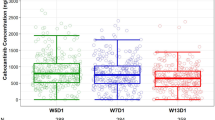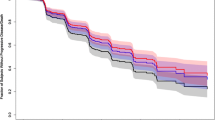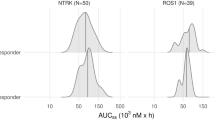Abstract
Cabozantinib, a multi-kinase inhibitor, is approved in the United States and European Union for treatment of patients with hepatocellular carcinoma following prior sorafenib treatment. In the Phase III CELESTIAL trial, hepatocellular carcinoma patients receiving cabozantinib showed longer overall survival (OS) and progression-free survival (PFS) than those receiving placebo. The approved cabozantinib (Cabometyx®) dose is 60 mg once daily with allowable dose modifications to manage adverse events (AE). Time-to-event Cox proportional hazard exposure–response (ER) models were developed to characterize the relationship between predicted cabozantinib exposure and the likelihood of various efficacy and safety endpoints. The ER models were used to predict hazard ratios (HR) for efficacy and safety endpoints for starting doses of 60, 40, or 20 mg daily. Statistically significant relationships between cabozantinib exposure and efficacy and safety endpoints were observed. For efficacy endpoints, predicted HR were lower for OS and PFS at 40 and 60 mg relative to the 20 mg dose: HR for death (OS) are 0.84 (40 mg) and 0.70 (60 mg); HR for disease progression/death (PFS) are 0.73 (40 mg) and 0.62 (60 mg). For safety endpoints, predicted HR were lower for palmar-plantar erythrodysaesthesia (PPE), diarrhea, and hypertension at 20 or 40 mg relative to the 60 mg dose: HR for PPE are 0.31 (20 mg) and 0.66 (40 mg); HR for diarrhea are 0.61 (20 mg) and 0.86 (40 mg); HR for hypertension are 0.46 (20 mg) and 0.76 (40 mg). The rate of dose modifications was predicted to increase in patients with lower cabozantinib apparent clearance. OS and PFS showed the greatest benefit at the 60 mg dose. However, higher cabozantinib exposure was predicted to increase the likelihood of AE and subsequent dose reductions appeared to decrease these risks.





Similar content being viewed by others
References
Global Burden of Disease Liver Cancer Collaboration (2017) The burden of primary liver cancer and underlying etiologies from 1990 to 2015 at the global, regional, and national level: results from the global burden of disease study 2015. JAMA Oncol 3:1683–1691. https://doi.org/10.1001/jamaoncol.2017.3055
Samonakis DN, Kouroumalis EA (2017) Systemic treatment for hepatocellular carcinoma: still unmet expectations. World J Hepatol 9:80–90. https://doi.org/10.4254/wjh.v9.i2.80
Yakes FM, Chen J, Tan J, Yamaguchi K, Shi Y, Yu P, Qian F, Chu F, Bentzien F, Cancilla B, Orf J, You A, Laird AD, Engst S, Lee L, Lesch J, Chou Y-C, Joly AH (2011) Cabozantinib (XL184), a novel MET and VEGFR2 inhibitor, simultaneously suppresses metastasis, angiogenesis, and tumor growth. Mol Cancer Ther 10:2298–2308. https://doi.org/10.1158/1535-7163.MCT-11-0264
Karagonlar ZF, Koc D, Iscan E, Erdal E, Atabey N (2016) Elevated hepatocyte growth factor expression as an autocrine c-Met activation mechanism in acquired resistance to sorafenib in hepatocellular carcinoma cells. Cancer Sci 107:407–416. https://doi.org/10.1111/cas.12891
Cabometyx® (cabozantinib) tablets (2019) US prescribing information. Exelix. Inc., Alameda, California. https://www.accessdata.fda.gov/drugsatfda_docs/label/2019/208692s003lbl.pdf. Accessed 9 Jan 2019
Cabometyx® (cabozantinib) tablets (2018) Summary of product characteristics. Ipsen Pharma, Boulogne-Billancourt, France. https://www.medicines.org.uk/emc/product/4331/smpc. Accessed 1 Feb 2019
Abou-Alfa GK, Meyer T, Cheng A-L, El-Khoueiry AB, Rimassa L, Ryoo B-Y, Cicin I, Merle P, Chen Y, Park J-W, Blanc J-F, Bolondi L, Klumpen H-J, Chan SL, Zagonel V, Pressiani T, Ryu M-H, Venook AP, Hessel C, Borgman-Hagey AE, Schwab G, Kelley RK (2018) Cabozantinib in patients with advanced and progressing hepatocellular carcinoma. N Engl J Med 379:54–63. https://doi.org/10.1056/NEJMoa1717002
Lacy S, Hsu B, Miles D, Aftab D, Wang R, Nguyen L (2015) Metabolism and disposition of cabozantinib in healthy male volunteers and pharmacologic characterization of its major metabolites. Drug Metab Dispos 43:1190–1207. https://doi.org/10.1124/dmd.115.063610
Nguyen L, Chapel S, Tran BD, Lacy S (2019) Updated population pharmacokinetic model of cabozantinib integrating various cancer types including hepatocellular carcinoma. J Clin Pharmacol 59:1551–1561. https://doi.org/10.1002/jcph.1467
Lacy S, Nielsen J, Yang B, Miles D, Nguyen L, Hutmacher M (2018) Population exposure-response analysis of cabozantinib efficacy and safety endpoints in patients with renal cell carcinoma. Cancer Chemother Pharmacol 81:1061–1070. https://doi.org/10.1007/s00280-018-3579-7
Miles D, Jumbe NL, Lacy S, Nguyen L (2016) Population pharmacokinetic model of cabozantinib in patients with medullary thyroid carcinoma and its application to an exposure-response analysis. Clin Pharmacokinet 55:93–105. https://doi.org/10.1007/s40262-015-0295-x
Author information
Authors and Affiliations
Corresponding author
Ethics declarations
Disclosures
Steven Lacy, Linh Nguyen, and Benjamin Duy Tran are stockholders and current employees of Exelixis, Inc.
Additional information
Publisher's Note
Springer Nature remains neutral with regard to jurisdictional claims in published maps and institutional affiliations.
Electronic supplementary material
Below is the link to the electronic supplementary material.
Rights and permissions
About this article
Cite this article
Nguyen, L., Chapel, S., Tran, B.D. et al. Cabozantinib exposure–response analyses of efficacy and safety in patients with advanced hepatocellular carcinoma. J Pharmacokinet Pharmacodyn 46, 577–589 (2019). https://doi.org/10.1007/s10928-019-09659-y
Received:
Accepted:
Published:
Issue Date:
DOI: https://doi.org/10.1007/s10928-019-09659-y




